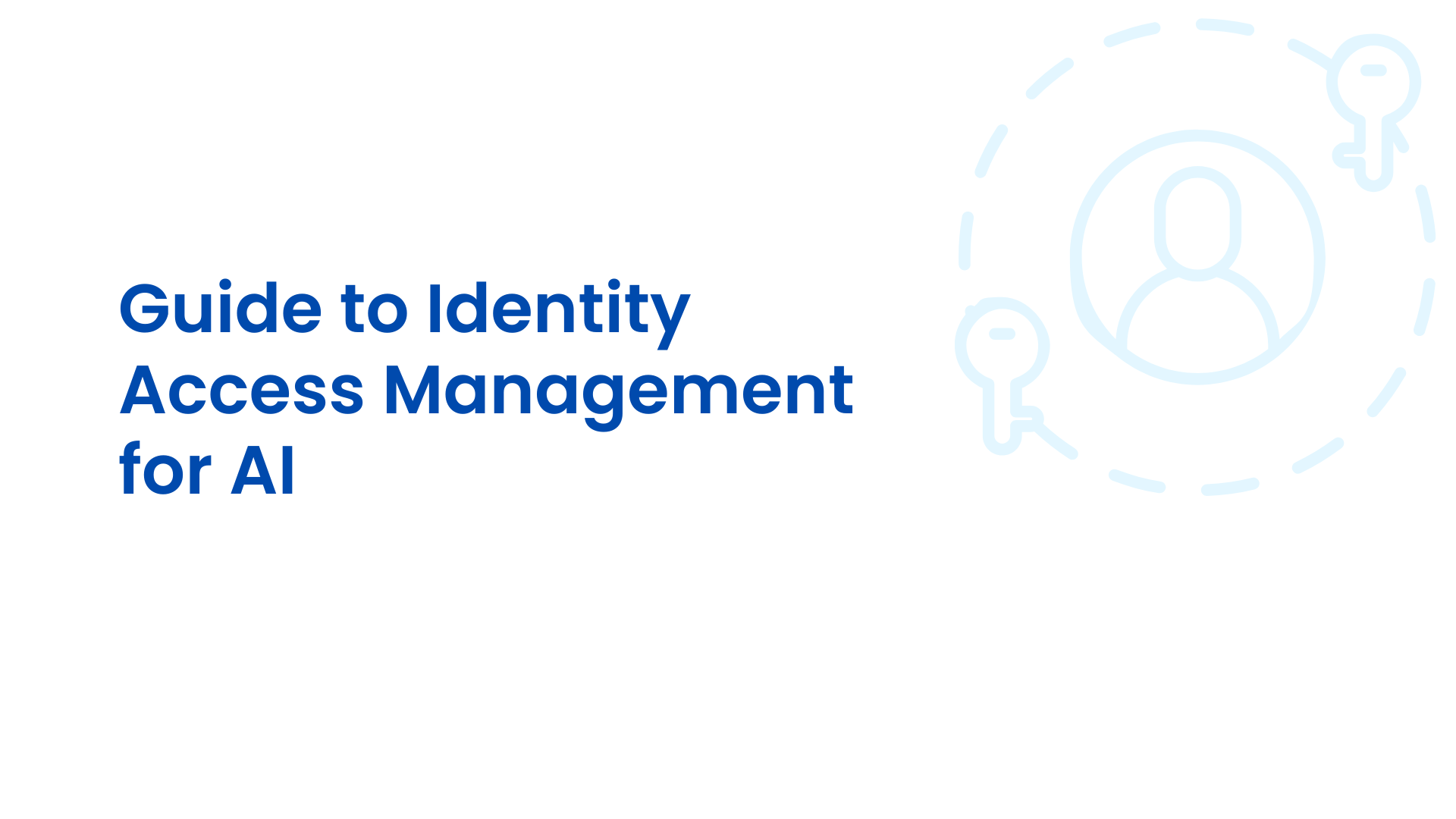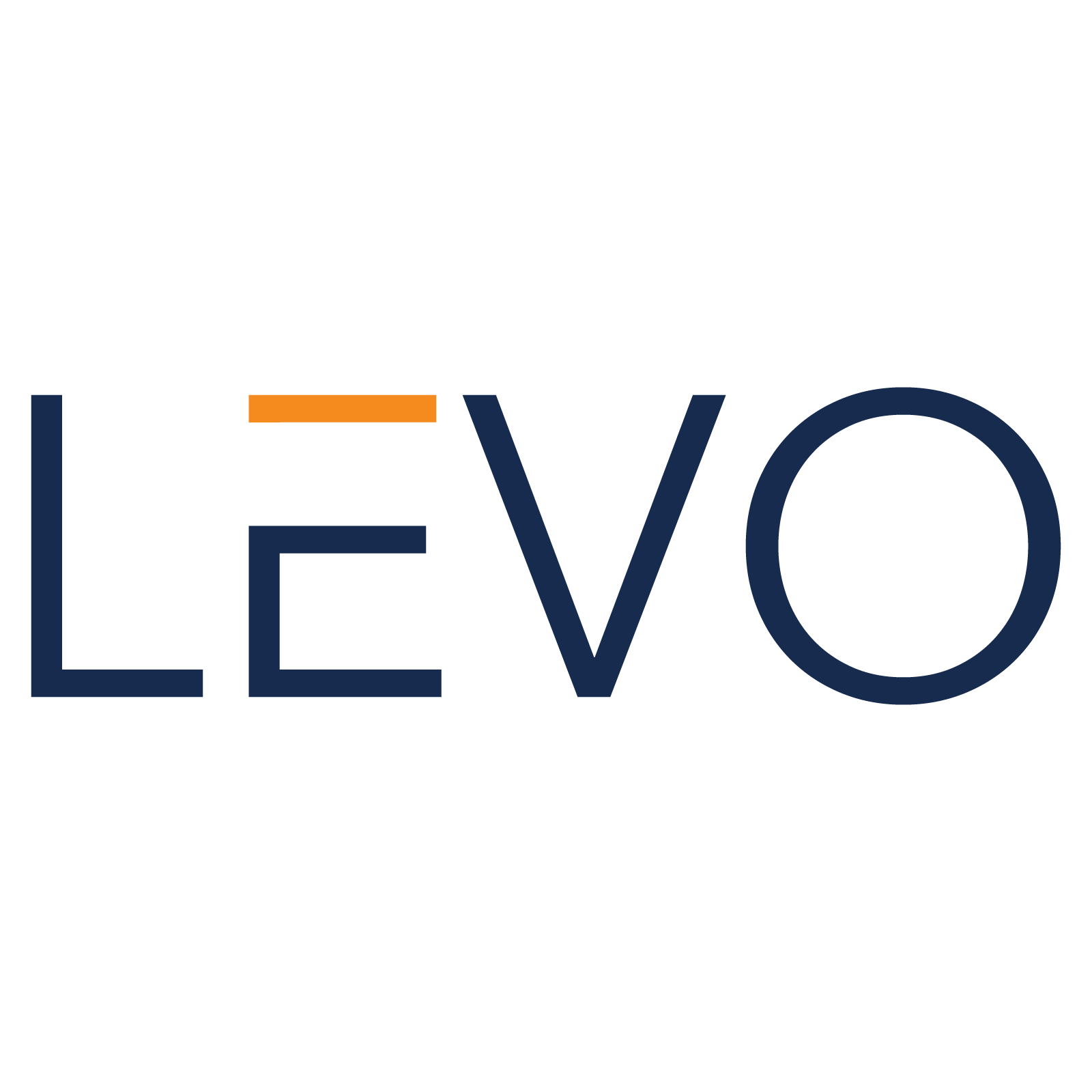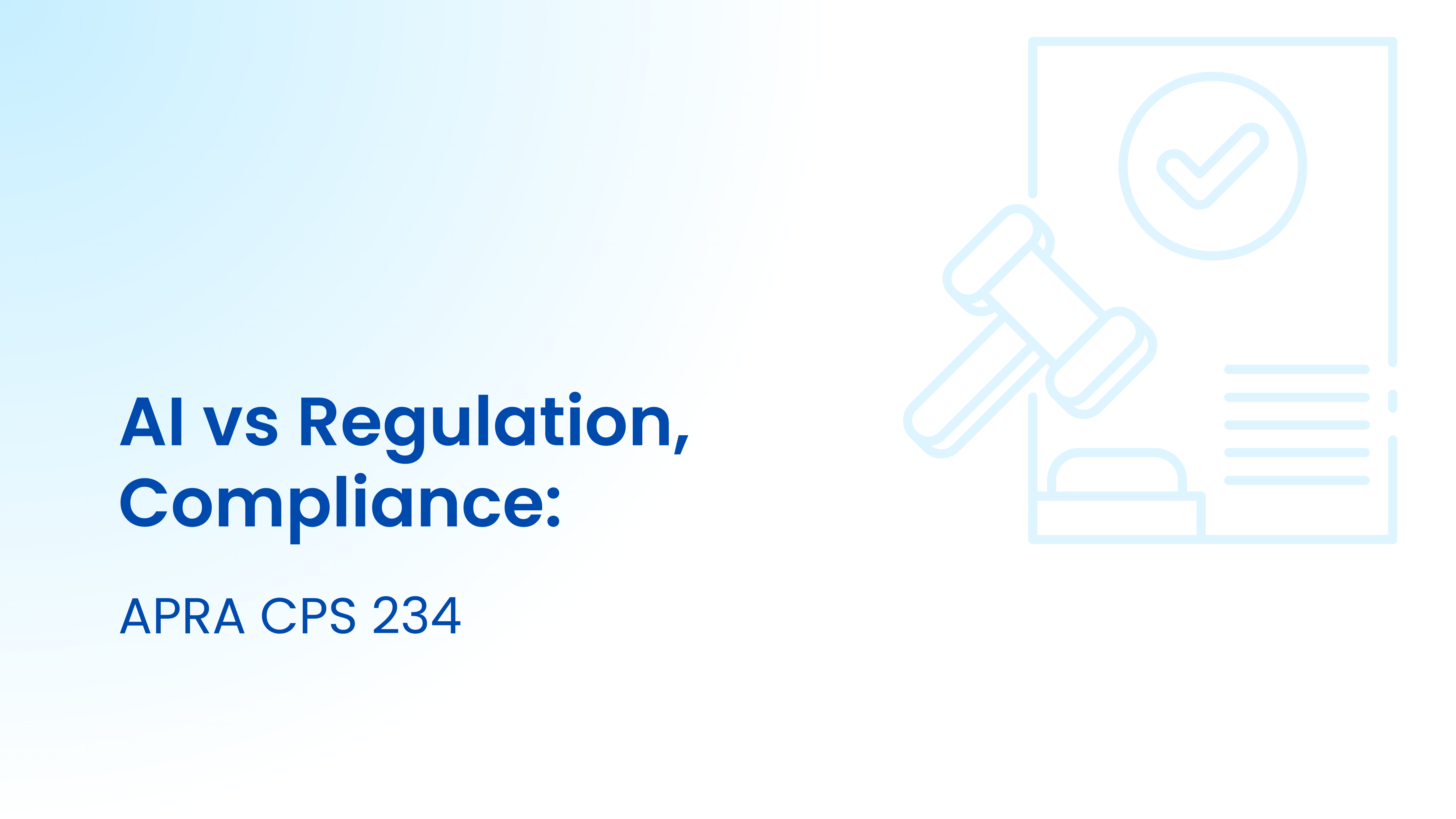How IAM, purpose built for AI protects against breaches, simplifies compliance, and unlocks safe, scalable deployment of AI systems.
Enterprises are racing to embed AI across workflows and applications, but success is increasingly defined by the ability to adopt necessary security fundamentals in lockstep.
Whenever enterprise infrastructure undergoes a major transformation, whether driven by cloud adoption, new data architectures, or now, AI, the security foundations beneath must also evolve in tandem.
Nowhere is this more apparent than in Identity Access Management: the layer that once protected sensitive data, enforced compliance, and limited breach impact is increasingly out of step with what modern AI native applications demand.
Traditional IAM was not built for AI systems that operate autonomously, make real time decisions, and interact with critical infrastructure and data.
When identity management is weak in AI systems, every new deployment increases security risk.
Giving agents too many permissions, relying on fixed roles, and failing to track who delegates what can all lead to data exposure and lateral movement, often without anyone noticing.
This blog explains why legacy IAM systems fail AI applications and explores how rethinking identity can unlock both rapid AI adoption and enduring market leadership.
Traditional IAM – Built for a Simpler World
To understand why AI native applications expose the limitations of legacy identity models, we must first revisit what traditional IAM was designed to achieve. Legacy IAM worked because enterprise systems were predictable, human centric, and static.
Users logged in, assumed predefined roles or attributes, and received coarse grained permissions; think “Finance team can read the ledger” or “Admin can manage servers”. Sessions persisted with trust, and applications executed deterministic workflows with predefined sequences, allowing developers to enumerate every API call or resource access in advance.
Access patterns were known in advance, enabling RBAC (Role Based Access Control), SSO, OAuth scopes, and PAM (Privileged Access Management) to function effectively.
This design made sense in a world of static actors and finite actions, but AI native applications operate on an entirely different plane: dynamic, autonomous, and context driven.
This is where IAM leaves a gap, because there is a clear mismatch between the intent behind traditional IAMs and the security requirements of the complex, dynamic and modern AI applications.
The risk surface expands further when AI operates under broad service identities. For example, a healthcare chatbot may access only generic data in one session but retrieve PHI in another. Legacy IAM treats these sessions identically, ignoring context, intent, and per query sensitivity. The result: blind spots, prompt injection vulnerabilities, and compliance gaps.
Static IAM rules are no longer sufficient, they are brittle, reactive, and blind to the complexity of AI driven operations which are dynamic.
AI Applications Redefine Architecture and Risk
AI native applications are not incremental changes, they redefine enterprise architecture, data flows, and threat models. Unlike traditional software, AI systems actively decide what actions to take, which data to access, and how to execute workflows, often crossing the boundaries that legacy IAM was designed to protect.
Emergent Behavior, Dynamic Tools, and an Expanded Attack Surface
AI introduces fundamentally new access challenges that legacy IAM cannot address:
- Non-deterministic actions: LLMs generate responses and API calls contextually. Unlike classic applications, developers cannot predefine every action the AI may take.
- Dynamic tool invocation: AI systems select plugins or auxiliary tools at runtime, executing context driven operations. IAM’s binary, all or nothing access model is too coarse, forcing enterprises to either overprovision (creating risk) or underprovision (limiting utility).
- Prompt injection and insider risk: Malicious inputs can manipulate AI to exfiltrate data. Legacy IAM cannot differentiate intent; it only sees a legitimate identity accessing resources.
- Broad service account scope: AI applications often run under a single identity with unrestricted access to sensitive datasets. The AI decides what to access in real time, but IAM cannot enforce context aware, purpose driven constraints, leaving organizations exposed to compliance and operational risk.
LLM Powered Systems and Retrieval‑Augmented Generation (RAG)
Large Language Models (LLMs) transform static queries into autonomous workflows. A financial research assistant, for example, can take a free form prompt, query multiple internal systems, and generate a structured answer for complex queries, all without human guidance.
The AI itself becomes an active decision maker, selecting which data to access and when.
Downstream, it may trigger actions such as sending emails or updating records, functioning as a mini orchestrator that expands its own operational scope in real time.
Traditional IAM, however, sees all activity as originating from a single service account. It is blind to per request nuances. and cannot distinguish between appropriate and risky requests, leaving enterprises blind to the AI’s emergent behavior.
Hybrid Cloud and Third Party AI Services
Modern AI applications often straddle organizational and cloud boundaries. Enterprises integrate external AI APIs, such as OpenAI, Azure Cognitive Services, or other SaaS models, into internal workflows, exposing sensitive data such as PHI, financial records, or intellectual property. While OAuth or API keys control who can call the service, IAM does not govern what data is transmitted. Sensitive information may leave the organization unnoticed. Legacy IAM ensures only authorized entities can call these services.
Since, it cannot enforce policy on the data itself, thus, creating blind spots for compliance and privacy.
Legacy IAM was not designed for runtime, content aware access across trust boundaries. Perimeter based access controls simply do not extend to dynamic AI interactions spanning external environments. Enterprises are left with partial visibility at best, and ungoverned exposure at worst.
Internal AI Productivity Tools
AI assistants embedded in developer environments operate at unprecedented speed and scale. They can traverse entire repositories, generate new code, or even commit changes autonomously. If granted the same privileges as human developers, these tools inherit broad read/write access. Granting human equivalent access risks inadvertent exposure or manipulation via prompt injection making them potential vectors for accidental or malicious data exposure. Prompt injection or other manipulations could co-opt the AI into acting against policy, effectively turning AI into an insider threat.
AI native systems are autonomous, adaptive, and boundary crossing. They render traditional IAM brittle, reactive, and insufficient. The assumptions that once underpinned enterprise identity, static roles, predictable workflows, and one time authorizations are no longer valid.
Across these scenarios, AI introduces emergent, non-deterministic behavior. LLMs and autonomous agents do not follow fixed workflows; they dynamically select tools, APIs, and data sources in real time. Traditional IAM’s one time, static authorization model cannot keep up. Enterprises are left with two unsatisfactory choices: over-provision access, trusting AI blindly, or restricting functionality, undermining business value.
Having established how AI architectures expand risk and evade static IAM controls, we will now examine precisely where traditional IAM fails in securing AI native applications, highlighting the urgent need for a new approach.
Key Limitations of Traditional IAM for AI Systems
AI native applications and autonomous agents introduce behaviors that traditional IAM was never designed to handle. Mapping these behaviors to IAM’s structural assumptions reveals why static identity controls fail in practice.
1. Static Permissions vs. Dynamic Needs
Legacy IAM relies on coarse grained, fixed roles or scopes assigned at login. AI systems, by contrast, require fine grained, just in time permissions tailored to each query, tool call, or task. Predefining roles for an autonomous agent is nearly impossible: over provisioning violates least privilege, while under provisioning breaks functionality. Assigning broad static permissions to inherently unpredictable entities is a critical security liability.
2. One Time Authorization vs Continuous Contextual Control
Traditional IAM assumes trust at authentication: once a user or service logs in, the session is authorized until expiration. AI agents, however, can pivot mid session, starting benignly and later performing high risk actions. Without continuous, context aware policy evaluation, IAM cannot detect or stop drift into dangerous behaviors. Real time assessment of agent intent, accessed data, and anomalous patterns is essential.
3. Human Identity Model vs. Multi Entity Delegations
IAM frameworks presume a single identity per session. AI workflows often involve multiple entities in a chain: user >> agent >>sub agent >> API. Standard tokens do not carry the full delegation chain, making audit trails and accountability unclear. Enterprises lose the ability to map actions back to the originating request, undermining both security investigations and compliance reporting.
4. Lack of Delegation Constraints
Protocols like OAuth or SAML handle simple user to application delegation but cannot enforce multi hop delegation or scope reduction. If Agent A delegates to Agent B, there is no standard mechanism to ensure B’s privileges are strictly narrower than A’s. Current IAM approaches either require custom, brittle solutions or result in insecure “all or nothing” delegation. Autonomous agents frequently cross organizational and trust boundaries, further compounding the gap.
5. Over Provisioning & Secret Sprawl
To prevent functionality failures, organizations often grant AI agents broad access and embed API keys across multiple services. This creates secret sprawl, a proliferation of credentials that increases the attack surface. Over provisioned privileges combined with unmanaged secrets dramatically amplify risk if an agent is compromised or misused.
6. No Support for Ephemeral Identities
Traditional IAM assumes long lived accounts. AI agents, however, may spin up for seconds or minutes per request. Manual provisioning cannot keep pace, and reusing shared identities violates least privilege and accountability. Issuing and tracking ephemeral credentials at scale is beyond the capabilities of most legacy IAM systems.
7. Slow Revocation & Lack of Kill Switches
Revoking access in legacy IAM is manual and slow, often tied to account or token expiry. If an AI agent misbehaves, there is no global kill switch to cut off its access across multiple systems instantly. Rogue agents can continue interacting with sensitive resources while revocation propagates or worse, indefinitely.
8. Limited Inspection of Content and Intent
IAM controls access based on who is requesting and what resource is targeted, but not why or what’s inside the data. An LLM querying a database could be retrieving legitimate summaries or exfiltrating sensitive information. Traditional IAM cannot detect malicious intent, content leakage, or policy violations embedded in AI outputs.
9. Inadequate Audit Trails
If multiple AI agents share generic service accounts, IAM logs only show that “svc-ai-bot called API X,” not the originating user request or agent instance. This breaks traceability, making compliance reporting and incident investigation nearly impossible. Many regulations, particularly in BFSI and healthcare require end to end auditability that legacy IAM cannot provide.
In short, traditional IAM is static and external, while AI applications are dynamic, continuous, and context driven. Applying legacy identity controls to autonomous, adaptive AI agents is akin to trying to contain a storm with a paper fence. As one security architect put it, we are “attempting to safeguard dynamic, independent agents with security techniques optimized for human operated, single purpose programs”, a strategy doomed to fail.
Consequences of IAM Failure in AI Contexts
IAM failure has dire consequences in context to AI applications, where even a runtime undetected vulnerability such as a poisoned prompt can lead to severe repercussions.
1. Security Breaches and Data Leaks
AI systems with over provisioned privileges can be manipulated to exfiltrate sensitive data or execute unauthorized actions. Prompt injection attacks and other manipulations have demonstrated how AI can bypass traditional controls, revealing secrets or sensitive data in seconds.
The scale of AI enabled breaches is striking: the average AI related security incident costs $4.8 million, exceeding traditional breaches ($4.45 million), and 73% of enterprises have already experienced at least one AI related breach.
2. Audit and Compliance Failures
Regulators and auditors require traceability and accountability. Legacy IAM cannot link AI actions to the originating request or agent instance. Without detailed audit trails, organizations risk failing SOC 2, HIPAA, or financial audits, delaying product launches, or incurring fines. Even beyond formal audits, partners and customers increasingly demand AI governance visibility; inability to demonstrate control undermines trust and can block business.
3. Incident Response Nightmares
When an AI agent goes rogue, revoking access is slow and manual, often spanning multiple systems. Without a centralized agent registry or global kill switch, responders cannot track all active instances, leaving rogue agents operational longer than intended. The result: minor incidents can escalate, requiring service shutdowns or reverting to slower manual processes, disrupting operations and increasing recovery costs.
4. Financial Fraud and Business Loss
In BFSI, poorly governed AI can bypass traditional controls due to autonomous access. A loan processing AI could approve illegitimate loans, or a trading bot might exceed risk limits. Traditional IAM relies on human separation of duties and approval workflows, AI acting as a “super user” bypasses these safeguards, exposing firms to direct financial loss and regulatory penalties.
5. Loss of Trust and Hesitancy in AI Adoption
Trust forms the basis of healthcare and finance. A single AI mishap, such as leaking patient data or internal financial records, can stall adoption for years. Developers and business teams, witnessing these incidents, may resort to hard coded credentials, shadow identities, or overly restrictive workarounds, further compounding risk and slowing innovation.
6. Developer Workarounds and Shadow Identities
Rigid IAM processes often push developers to bypass controls. High privilege API keys might be hard coded, shared across agents, or left unmanaged, creating shadow IAM practices. These workarounds undermine security visibility, complicate incident investigation, and exponentially increase the attack surface.
7. Inability to Meet Future Regulatory Demands
Emerging regulations, such as the EU AI Act, will likely require agent level identity, access control, and runtime oversight. Organizations without AI aware IAM are at risk of costly retrofits or being forced to pull AI products from production. Preparing IAM for AI today is not optional, it is strategic risk management.
Applying traditional IAM to AI native systems is inadequate and dangerous. The consequences span security, compliance, operational continuity, financial risk, and trust. Conversely, proactively adapting IAM for AI not only prevents breaches and fines but also strengthens governance, enables confident adoption, and supports scaling AI initiatives safely.
Who feels this pain the most? Regulated industries like BFSI and healthcare are at the forefront, offering critical lessons on how IAM must evolve to meet AI’s demands.
Regulated Industries: High Stakes, High Constraints
No sectors feel the tension between AI opportunity and IAM inadequacy more acutely than banking, financial services, and healthcare. These industries stand to gain the most from AI driven efficiency and precision, yet face the most unforgiving regulatory and operational constraints.
The result is a paradox: the strongest business case for AI exists where its deployment is most tightly shackled by identity and security gaps.
Banking & Financial Services (BFSI): Innovation Meets Regulation
The financial sector is in the midst of an AI revolution, or at least trying to be. 78% of banks are piloting generative AI, yet only 8% have scaled deployments as of 2024. The business case is undeniable: automating back office tasks, enhancing fraud detection, and accelerating compliance reviews can deliver multimillion dollar ROI. But traditional IAM architectures, designed for human workflows, cannot uphold separation of duties, transaction integrity, or auditability in autonomous environments.
When AI systems initiate actions from updating loan records to executing trades, existing identity layers treat them as generic service accounts. This erases accountability. Early incidents of misused credit APIs and data leaks have already underscored the risks of granting agents unbounded access. Regulators now expect model risk management to include identity aware controls, proving not just what a model did, but who (or what agent chain) performed each action. Without this, scaling AI across financial operations remains untenable.
Healthcare: Precision Meets Privacy
Healthcare leaders are equally eager yet constrained. 85% of healthcare executives believe AI will transform clinical decision making, but only 30% of pilots reach production. Nearly half cite security and privacy as the primary blocker. Hospitals and providers are experimenting: 30% already use AI scribes, and 60% have formal AI governance committees, but expansion stops when identity risk enters the equation.
A clinical assistant that drafts notes or retrieves patient history cannot simply run under a single shared identity; every interaction must be attributable, constrained, and compliant with HIPAA and PHI access rules. Without fine grained, context aware IAM, even a well intentioned AI could expose protected data or make untraceable recommendations. In an environment where lives and liability intersect, trust must be mathematically verifiable, not assumed.
Hybrid Models and Human Oversight
Across both sectors, enterprises increasingly prefer self hosted or hybrid AI architectures; 80% report wanting local enforcement and auditability rather than fully managed, opaque AI services. For high risk decisions, they insist on human in the loop approvals, embedding accountability into every action path.
Meanwhile, 45% are exploring multi agent systems, where AI entities collaborate dynamically. This amplifies delegation complexity, who authorized what, when, and under what context, rendering static IAM frameworks obsolete.
These preferences aren’t signs of conservatism; they’re signs of realism. Enterprises know that AI’s potential will never be unlocked until they can trust agent autonomy without sacrificing compliance. That requires a new identity foundation purpose built for AI.
The Emerging Opportunity: Secure, Identity Aware AI
There’s a clear market signal: 51% of regulated enterprises are open to adopting AI agent solutions from startups, but only if trust and security are provable. The market isn’t waiting for incumbents to retrofit legacy IAM; it’s looking for AI native identity platforms that integrate runtime visibility, continuous authorization, and granular delegation tracking.
This is precisely the gap platforms like Levo are designed to fill, enabling enterprises to scale AI responsibly, with identity as the core control plane rather than an afterthought.
But the question is “What can enterprises do about it?”, The next blog in the series introduces Zero‑Trust Architecture for AI applications, where Levo scrutinizes traffic at runtime offering complete visibility, extensive runtime detection and protection.
Toward Zero Trust for AI and Beyond
As enterprises confront the new realities of AI driven systems, one truth is becoming clear: trust must become dynamic. Static permissions and one time approvals no longer suffice when actions are generated on the fly, data flows shift in real time, and AI agents collaborate autonomously. The next frontier in security is a Zero Trust Architecture built for AI, one that continuously verifies every decision, every prompt, and every tool invocation.
From “Trust Once” to “Always Verify”
Traditional IAM assumes that once a user or service is authenticated, it can be trusted for the duration of the session. In AI environments, that assumption breaks. Each prompt, retrieval, or downstream call may change the intent and context of execution.
A Zero Trust approach for AI replaces static trust with continuous, contextual verification, ensuring that every action is authorized not just by who initiated it, but by why, when, and how it occurs.
Runtime Visibility as the New Control Plane
Visibility is the foundation of trust. Emerging AI security stacks now instrument real time monitoring of prompts, tool invocations, and data flows, turning opaque agent behavior into actionable insight. With runtime intelligence, security teams can evaluate risk continuously, enforcing adaptive controls that evolve with the model’s behavior instead of lagging behind it.
Capability Based Delegation and Agent Registry
To restore accountability in autonomous environments, IAM must evolve toward capability based delegation. Each AI agent receives just in time, narrowly scoped credentials, tied to its current task and context.
Delegation chains carry identity metadata, ensuring that every action, even across multiple agents, can be traced back to its origin. Tokens expire quickly and can be revoked instantly, reducing the blast radius of any misstep or compromise. This transforms access from an open ended permission to a controlled capability that lives only as long as it’s needed.
Levo’s Promise: Turning Zero Trust into Reality
At Levo, we believe identity is the backbone of safe AI adoption. Our eBPF powered runtime instrumentation enables deep visibility into AI call graphs, reconstructing how agents reason, retrieve, and act.
Levo attributes every session to a verified identity, enforces real time guardrails, and provides immutable audit evidence, all without requiring code changes or architectural rewrites. This is what turns AI ambition into safe, compliant, and scalable deployment.
In our next post, we’ll break down the Zero Trust Architecture for AI Applications, exploring how to design for safety, compliance, and innovation without slowing development velocity. Stay tuned!
Bottomline: Fix the Foundation Before You Scale
The paradox is stark: while organizations race to deploy AI agents and co-pilots, they are doing so atop identity systems designed for static users, predictable workflows, and neatly defined trust boundaries. That mismatch is not just technical debt; it is a strategic vulnerability.
The future belongs to those who can operationalize AI safely, not just quickly. Before scaling your next agent or deploying another LLM integration, take a hard look at where your access controls break down, where shared service accounts hide intent, where policies cannot adapt to dynamic actions, and where blind spots prevent visibility into what your AI systems actually do.
Securing AI begins with rethinking identity itself, from static entitlements to contextual, continuous, runtime aware control.
This series is your guide to that transformation. In our next post, we will unpack the Zero Trust Architecture for AI applications, showing how dynamic verification and runtime enforcement redefine what secure by design means in the age of intelligent agents. After that, we will explore how Google’s emerging AP2 protocol is reshaping agent identity and delegation standards.
At Levo, we help regulated enterprises deploy AI safely by providing end to end runtime visibility, adaptive guardrails, and pre deployment testing that make trust measurable and compliance automatic.
Ready to make your AI ambitions secure by design?
Contact Us to see how Levo enables safe, compliant AI adoption and help you scale with confidence.








